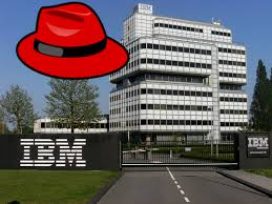Why IBM's In a Race Against Time

IBM (NYSE: IBM) is in a race against time, and investors are losing patience — even as executives maintain the company’s hybrid-cloud-and-AI strategy is on track to achieve ambitious goals next year.
The latest earnings report from Big Blue showed revenues for 4Q of 2020 fell 6% year-over-year. Quarterly operating EPS was $2.07, down 56% year-over-year and 18% sequentially. For the full year 2020, revenues of $73.6 billion were down 5% year-over-year, and operating EPS of $8.67 was down 32% from last year’s $12.81.
IBM gave many good reasons for the drops, including quirks in a mainframe sales cycle and a lapse in customer willingness to sign long-term software agreements. Still, the market pounced on the stock. driving it down nearly 8% in after-hours trading.
IBM’s NewCo Challenge
IBM’s plan is to focus on its artificial intelligence (AI) technology and its hybrid cloud product and services lineup, spearheaded by Red Hat, as the company’s saving graces. This has been CEO Arvind Krishna’s message since taking charge last April. The question seems to be whether the strategy can work quickly enough, given the factors that stubbornly drag the company’s coattails and seem to deflect resources from the mission.
Chief among the distractions is what is proving to be a long, hard struggle for IBM to spin off major portions of its services business to a new public company, temporarily dubbed “NewCo,” by year end 2021. Despite eschewing other guidance, execs claim IBM can reach mid-single-digit revenue growth by 2022, after the separation.
“We are executing on our detailed plan to achieve the milestones to create a stand-alone company,” said IBM CFO James Kavanaugh on last night’s conference call with analysts. “Today, we are working with works councils on employment terms, establishing NewCo's legal entities across the world, drafting the agreements, which outlined the ongoing relationship between IBM and NewCo, and developing audited financials.”
That means IBM is working to establish, this year, a company of over 90,000 employees in 115 countries, along with 4,600 customers clamoring for a $60 billion services backlog in a business segment that saw an 8% revenue decline in 2020. And while IBM has announced the appointment of Martin Schroeter, a longtime IBMer who served as the company’s CFO and as an SVP of global markets, to head up NewCo, there’s every indication that the challenge of closing this transaction will be formidable.
Red Hat May Not Be Enough
The NewCo distraction is only part of what seems to be dragging on IBM. While the hybrid cloud strategy based on Red Hat is solid and clearly defined, it may not be enough to draw all of IBM’s many moving parts into a clear pathway to profit.
For Q4 2020, Red Hat revenue was up 18% compared to 24% for last year’s quarter. Good numbers, but not great, given that some competitors, such as Hewlett Packard Enterprise (HPE) saw Q4 2020 revenues increase sequentially and yearly revenues flatten to roughly match pre-pandemic levels.
Analysts also question whether IBM may be missing the boat in failing to articulate clear marketing messages about the secure edge, multi-cloud networking, or software-defined wide-area networking (SD-WAN). As one questioner put it last night:
“[I] hear your assurances around the current spending environment. I guess the question is -- and the elephant in the room is how do you know that there isn't something more sinister afoot here. That there is an accelerated migration to the cloud that … IBM is not participating in or … some of your software offerings in Cloud & Cognitive are not as competitive as you might think, and that's ultimately what's being reflected here.”
IBM Banks on HIdden Strengths
To these and other challenges, IBM execs dig into the numbers to produce a range of hopeful reasons for future success. Total cloud revenue was up 19% for 2020. There are 2,800 customers — including Barclays, Walmart, GEICO, Airbus, and Ford — using Red Hat’s platform, up 40%. There has been growth in applications for security and Internet of Things (IoT). And Global Business Services, which includes consulting on Red Hat and hybrid cloud, is expected to reach pre-pandemic levels by the middle of 2021.
IBM also points to a series of margin improvements, debt reduction, and increased free cash flow as indicators it’s on the right track. Further, the company has invested over $1 billion in boosting incentives for its channel and in growing its ecosystem of resellers and technology partners. And with $13 billion-plus in cash at hand, it’s ready to invest in M&A as needed. (That could be enough to bring a unicorn or two on board.)
Whether all of this can get IBM to where it wants to be fast enough to please its stakeholders is a question. But it’s one that Arvind Krishna and his team are betting their careers on answering positively.


